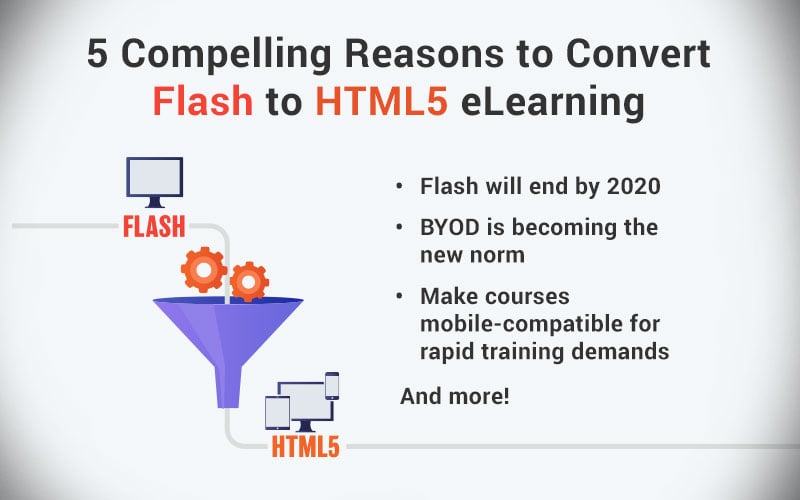How the 4 Rs of Rapid eLearning Impact the Conversion of Legacy Courses into HTML5

Are you unsure about the fate of the pool of legacy eLearning courses that are lying in your course library? Looking for ways to repurpose them? Well, worry not as rapid eLearning brings you the magical solution to revamp your legacy courses and give them an all-new look and feel.
Legacy courses; developed in software like FLASH that is obsolete today, can still have a lot of relevant content, and to give them a new life, they are converted into HTML5 format. You can utilize rapid eLearning solutions to convert the legacy courses into HTML5 to deliver fast and effective training through eLearning. Various rapid eLearning authoring tools make it hassle-free to create rapid eLearning courses that are accessible on your preferred device, unlike legacy courses that were only accessible on your desktop.
Trying to Convert Legacy Courses into HTML5? Try Rapid eLearning Solutions.
Explore these 4 Rs to Assist your Conversion Process –
- Record
- Republish
- Rebuild
- Redesign
Read on to understand the benefits of converting your legacy courses into HTML5.
Advantages of Developing Rapid eLearning Courses in HTML5 Format
1. Improves Training ROI for the Organization
Developing rapid eLearning courses with the help of authoring tools to deliver the end product in HTML5 helps the employees to access their training remotely. HTML5 is an open-source language that does not need any external plugins to run it, making it compatible with multiple modern devices such as laptops, tablets, and mobile phones. This ensures the courses are developed in relatively less time on a minimal budget, where the quality stays professional, enhancing the overall training ROI for the organization.
Evaluate the impact of eLearning in your organization and ensure the best results.
2. Allows Easy Updates and Improvements
The legacy courses developed earlier were limited in terms of their instructional design, graphics, visuals, interactivity, and flexibility. When the courses are built in HTML5 format, it uses the latest technology, and thus, more options are available to the developers without complications. Modern authoring tools have a lot of features that facilitate easy updates and modifications to the courses. They can be edited whenever required to improve their quality of interactivity and keep up with the latest eLearning trends.
3. Enhances eLearning Experience of Corporate Employees
When employees get uninterrupted access to training through HTML5-based eLearning courses, it facilitates a continuous learning environment and promotes a learning culture within the organization. Since HTML5 is supported on any device without an extra plug-in, it makes the training more flexible and productive. Whether your preferred format is classroom training, microlearning, performance support training, or simply a mix of all these formats, HTML5 courses can easily be accessed on demand.
They can be published offline as well, making training relatively easier for remote employees having an unstable internet connection or field employees who aren’t present at the workplace most of the time.
4. Makes the eLearning Translation Process Easy
HTML5 courses are very easy to access and update, so it’s easy to utilize the power of modern authoring tools or external AI tools and translate them into multiple languages. Legacy courses, on the other hand, are very hard to translate efficiently. Even when you are outsourcing your eLearning translations, your vendor can easily access your HTML5-based courses and do the work productively under tight deadlines.
How the 4 Rs of Rapid eLearning are Influential to Convert Legacy Courses into HTML5
Since the advantages of converting your courses into HTML5 have been mentioned, it’s important to understand the basic strategies of conversion. Let’s find out how the 4 Rs of rapid eLearning eases the process.
1. Record
This strategy is useful when you don’t have access to the source files of your legacy courses and its content is very limited in terms of interactivity. You can record these courses in mp4 format to make the recording easily accessible for everyone. Now you can trim the video and take out the relevant stuff as simple recall assets for job aids or use the recording in your ILT and VILT sessions.
2. Republish
There is a great possibility that you might have the source files of the legacy courses if they were built on the older versions of any authoring tool. So, if you have those source files, you can use the republish strategy to give it a modern touch and publish its updated version in HTML5 format. Before publishing, you can also make changes to the on-screen functionalities and interactivities. You can update the data, stats, visuals, graphs, and other outdated content before republishing the courses.
3. Rebuild
Some of the media elements like certain infographics, diagrams, or images in the legacy courses can still be relevant and it won’t be a good idea to scrap them all, so use the rebuild strategy to make productive use of those media assets. A rapid authoring tool will help you rebuild the course into HTML5 format by incorporating the relevant assets throughout the course, eventually giving a new life to those raw assets. Use the latest features of the authoring tools to add new media elements along with your existing assets effectively to enhance your eLearning courses.
4. Redesign
The complexity of converting from legacy to HTML5 increases as we move toward this strategy, because here you have to focus on multiple aspects like course structure, instructional design, asset upgrades, or microlearning conversions. It’s obvious that the legacy courses were designed a few years ago and due to the fact that the world has been constantly developing, your courses might need a revamp.
Whether you have to add a lot of new content, add various interactivities, or make them translation-friendly, you should prefer this strategy to redesign the legacy courses into HTML5 from scratch. You can also reduce the time required to complete the courses, make the courses accessible on multiple devices, and even change the delivery format into learning nuggets to make your training more impactful and engaging.
Parting Thoughts
Converting legacy courses into HTML5 is one of the most essential upgrades your eLearning courses need. There are various rapid authoring tools available that can make the conversion through their distinct features but choosing the right tool that completely fits your training requirements is still a challenge on its own. Every tool has all the basic authoring features but keeping things basic isn’t preferred in this dynamic world. Refer to this free eBook to figure out the advanced features of multiple authoring tools and choose the best authoring tool for your eLearning development processes.





